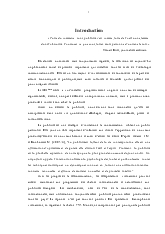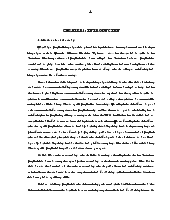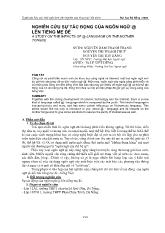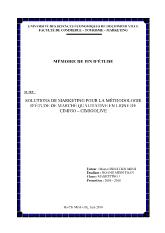A vietnamese – american cross cultural study of touching behaviour
- Người chia sẻ : vtlong
- Số trang : 71 trang
- Lượt xem : 9
- Lượt tải : 500
Các file đính kèm theo tài liệu này
 MA%20thesis.doc
MA%20thesis.doc
- Tất cả luận văn được sưu tầm từ nhiều nguồn, chúng tôi không chịu trách nhiệm bản quyền nếu bạn sử dụng vào mục đích thương mại
Bạn đang xem trước 20 trang tài liệu A vietnamese – american cross cultural study of touching behaviour, để xem tài liệu hoàn chỉnh bạn click vào nút DOWNLOAD LUẬN VĂN ở trên
I. Rationale
Touch, known as haptics or tactile communication, is often considered to be the most basic form of communication that each of us experiences from birth. As well, it is a fundamental aspect of nonverbal communication in general and of self-presentation in particular. To some extent, body contact is related to proximity – one can only touch if one is within close range of the other person. The closer we stand to one another, the more we increase the likelihood of our touching. Touch is also a crucial aspect of most human relationships. It plays a part in giving encouragement, expressing tenderness, showing emotional support, and many other things. Some say it reflects a yearning for human contact and a desire to restore some unfilled tactile needs. The act of touching is like any other message we communicate – it may elicit negative reactions as well as positive ones depending on the configuration of people and circumstances.
In addition, how we feel about touch usually depends on the meanings of touch we perceived. For example, our meanings are affected by the part of the body that is touched, the duration of the touch, the amount of pressure that is applied, and the amount of movement after absence of another person, the importance of any other person who is present, the situation in which the touch occurs, the mood created by the situation, and the relationship between the people involved.
Moreover, some research reports that boys and girls get differential early experiences with touch from parents, but most agree that early experiences with touch are crucial for later adjustment.
In this thesis, we will discuss touching behaviours and its effects on human communication. Additionally, we will compare and contrast the way Vietnamese and American informants apply touching with certain subjects. Hence, we will draw out some similarities and differences with the view to suggesting solutions to cultural shock and communication breakdown.
II. Aims of the study
The aims of the study are:
To investigate touchable areas on human body.
To compare and contrast areas of touching on human body and the influence of the informants’ parameters on touching in the two cultures in order to clarify similarities and differences in the way the Vietnamese and the American apply touching.
To contribute to raising cross-cultural awareness of the potential culture shock in touching behaviours, thus avoiding communication breakdown.
III. Scope of the study
The study stresses upon the nonverbal communication. Extralinguistically, the study especially discusses the touching behaviours in the two cultures: Vietnamese and American.
IV. Methods of the study
In order to achieve the objectives of a cross-cultural research mentioned above, the major method to be employed is quantitative. Besides, contrastive analysis is also used. Therefore, all the considerations, comments and conclusions in this thesis are largely based on:
Reference to relevant home and foreign publication in both primary and secondary research.
Survey questionnaires.
Statistics, descriptions and analysis of the collected and selected data.
Personal observations and experience.
Consultations with supervisor.
Discussions with Vietnamese and foreign colleagues.
V. Comments on the survey questionaire
The survey questionaire is designed to investigate the cross-cultural simmilarities and differences in touching behaviour between the Vietnemese and American culture. In order to collect sufficient data for contrastive analysis, the author designed two types of survey questionaires: one in English and the other in Vietnamese. The survey was conducted with both Vietnamese and American informants. The author has recived answers from 60 Vietnamese and 60 American informants. They were required to tick the appropriate boxes, corresponding to where they applied touching, what types of touching behaviours they employed and they also provided some personal information to help produce a more precise result (such as age, gender, marital status, etc.) The data was then analyzed from a cross-cultural perspective, in the light of nonverbal communication.
The survey questionaire contained the following situation:
(1) After one week out of touch with the following people, identify who touched you where.
(2) Identify how often you get touched by the following people.
(3) What would be your reaction if one of the following people touch you, after one week out of touch with him/her?
(4) Identify what kind of touching behaviour you apply on different body regions for the following people after one week out of touch with him/her.
In these situations, informants had to choose who they would apply certain type of touching behaviour.
The informants’ communicating partners were people in family, social and business relations:
Mother
Father
Brother
Sister
Close same-sex friend
Close opposite-sex friend
Same-sex acquaintance
Opposite-sex acquaintance
Same-sex colleague




